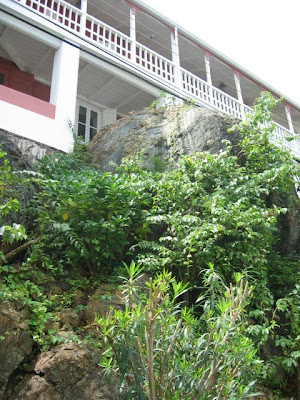The rocks in the islands are beautiful. They are mostly volcanic in origin, which means they are very hard. In fact the islands are made up of some of the hardest rock in the world. It's so hard diamond drill bits break. It's so hard they call it, ahem...blue bitch. It's so hard that houses are sometimes built around boulders that cannot be blasted away. As in this picture.

At our guest house at Lille Maho there was a three foot tall somewhat triangular shaped rock around which was build our back porch. It stood defiantly between the bedrooms and bathrooms and was the cause of many night-time bruised shins and busted toes, not to mention choice curse words.
The rocks in the islands are filled with different colors, textures. They can be various shades of blue, which is where blue bitch gets its name. They can be veined with quartz. They can be rusty orange, evidence of iron in their blood. They can be grey or black. Each has its own shape.
This is a typical stacked stone wall. It is several hundred years old, built during the slave days.

Here's the windmill at Annaberg on St. John. When I was little a family actually lived in it. There was second floor made wood.

This is the outside wall of boiling house at Annaberg, where sugar cane juice was boiled down to make sugar. Side products were molasses and rum. You can see yellow and orange brick. They came from Europe as ballast on the sailing ships. The arched "holes" are where the fires were built.

This is inside the boiling house. That round thing in the center is one of the iron boiling pots. Under it is one of those holes where the fires were. Look at all those rocks! Each one placed there by the hands of slaves.

The next three pictures are taken at the Pissarro Building on St. Thomas. I like to imagine Camille as boy running through this particular alleyway, seeing these colors, which later translated and his wonderful ability to capture color and light in his paintings. I like to think it all started here, with these rocks and bricks. Truth be told, the walls were probably plastered when he was a kid in the 1830s and 40s.

This last picture was taken at the Old Stone Farm House, now a restaurant. Through the window you can see my sister being served by a waiter. Originally is was a dairy farm. Cows were milked where she is sitting. This dairy farm goes back to Danish times and was still in operation when I was growing up. My sister went to school with the owner's daughter. They were classmates. The building is several hundred years old.



My brother is a geologist. When he was in college I thought that boring, but now I love rocks. Great pictures.
ReplyDeleteNancy
N. R. Williams, fantasy author
Those are fabulous! I used to 'collect' rocks when I was a kid. All the little ones with either interesting shapes or colors went into a sock I hid in my dresser drawer. Didn't know what any of them were, I just liked looking at them!
ReplyDeleteWhat a contrast between the cairns and these ... talk about things that last. I do so love stone buidings. Great picture.
ReplyDeleteFascinating. I know next to nothing about St. John. Now I know more.
ReplyDeleteGreat post. I took geology as a subsidiary subject when at university over 50 years ago. I was fascinated by rocks then - and still am.
ReplyDeleteJust one question:- towards the end you refer to Danish times, What is the connection with Denmark?
So many stories in those walls and towers. Beautiful, Bish.
ReplyDeleteThanks everyone.
ReplyDeleteBob, the U.S. Virgin Islands were owned by Denmark until 1917 when the U.S. bought them. The Danes settled St. Thomas in 1671, claimed St. John in 1717 and bought St. Croix from France in 1733.
Thank you for explaining Bish. You are never too old to learn something new. Obviously my geography was not as good as my geology!
ReplyDeleteI love stories with bits of local color, like a rock called "blue bitch". Things like that are what makes life interesting. Thanks for the island insight!
ReplyDeleteRocks are great; your pictures are breathtaking. I absolutely love that old stone wall!
ReplyDeleteTruly breathtaking photos, such inspiration and depth behind the stones and how they came to be!
ReplyDeleteWonderful. I love posts like this. One of my favourite things to do when traveling round NZ is to go through cemeteries looking at the old headstones.
ReplyDeleteHow interesting that rocks are incorporated right into the buildings there. I saw a couple of houses built around rocks in Cyprus, but nothing quite like that guest house.
ReplyDelete